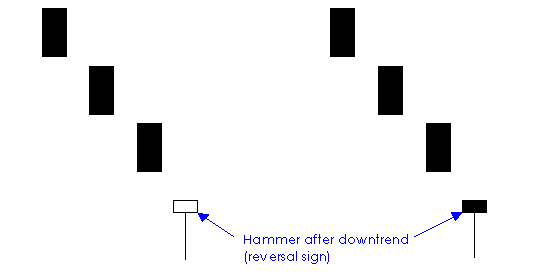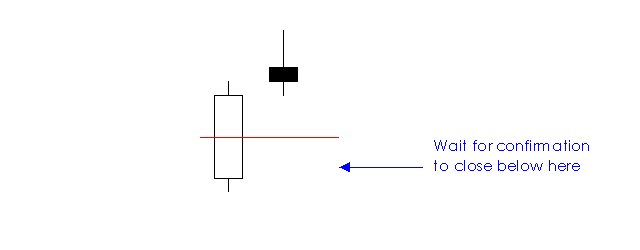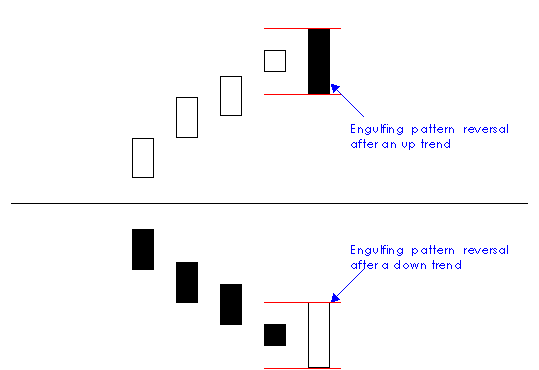
Japanese Reversal Charting Patterns
In the 1600s, the Japanese developed a method of technical analysis to analyse the price of rice contracts. This technique is called candlestick charting.
Candlestick reversal pattern analysis is based on Japanese Candlestick reversal patterns.
The candlestick reversal pattern analysis identifies reversals based purely on the candlestick theory. It does not involve the volume confirmation.
When you see the reversal signal on the chart, you should carry out further analysis on its price pattern, trend lines, and appropriate indicators. The reversal patterns are plotted on the chart as one of the indicators.
The letter on each reversal signal represents the first letter of the reversal pattern. The following is the list of patterns and corresponding symbols that are shown on the chart.
|
Candlestick Reversal Pattern |
Symbol on chart |
|
Doji |
d |
|
Hammer |
h (in the down trend) |
|
Hanging man |
h (in the up trend) |
|
Shooting star |
s |
|
Morning star |
m |
|
Evening star |
e |
|
Dark cloud cover |
D |
|
Piercing line |
P |
|
Engulfing pattern |
E |
Sharechart Default: 3 period

One trading technique used with doji’s is the Doji star; it is very similar to the evening star, however the second candle consists of a small doji followed by a strong red candle signalling the reversal. The doji will warn you that there is indecision and that a trend reversal is possible.

The opposite pattern to this is also tradeable, it is the morning doji star, this is exactly the same as the morning star pattern, but with the second candle being a doji. A morning doji star and a doji star are both stronger signals than the ordinary morning star and evening star.

Hammers and Hanging men are one- day price reversals.
Hammers are umbrella shaped candles occurring after a price decline and get their name because they are ‘hammering’ out a bottom. They are characterised by a day in which prices slip sharply from the opening price during the trading session, then return to close near the high of the day. This signals that the bears tried to gain control but were unsuccessful.

Hanging men, on the other hand, are umbrella shaped candles that develop after a rally. The small real body can be compared to the head of a man, and the long shadow his legs dangling down. The shadow needs to be at least twice the size of the body.

Note: The colour of the candles does not mater for both the hanging man and the hammer.
The shooting star is a short-term top in which, after a strong advance, the price action creates a small gap up and a small green filled real body appears at the end of a long wick or upper shadow.
This shows that the bulls could not gain control and that the bears are resisting, forcing a possible retreat of the upward trend.

The morning star is a bottom reversal pattern, named after the sunrise (market rise) that follows the pattern. It takes three candles to form a Morning star:
Candle 1: An extended red real body. Showing that the bears are in command.
Candle 2: A small real red body that doesn’t touch the prior real body. The small real body means sellers are losing the capacity to drive the market lower.
Candle 3: The final candle of the morning star is a green real body that intrudes deeply into the first sessions red candle. This indicates that the bulls have gained control and the stock is preparing to rise.

The evening star is the bearish version of the morning star pattern. It is named after the planet Venus, which appears just before the darkness sets in. The evening star is a top reversal and is seen at the end of an up trend. Again it takes three candles to form the pattern:
Candle 1: An extended green real body. Showing that the bulls are in command.
Candle 2: A small green real body that doesn’t touch the prior real body. The small real body means buyers are losing the capacity to drive the market higher.
Candle 3: The final candle is a red real body that penetrates deep into the first sessions green candle. This indicates that the bears have gained control and the stock is preparing to dive.

Factors increasing the likelihood of either the evening star or morning star being a reversal include:
The Dark-Cloud cover is a double candle pattern that is a top reversal after an up trend, or sometimes at the top of a congestion band.
The first day candle is a strong green real body; the second days candle opens above the prior sessions high (above the top of the upper shadow). However, by the end of the second days session the market closes deeply within the prior days green body.
The further the second candle penetrates into the prior days green body, the more likely it is to be a top.
It can heighten the chance of a top if the second candle opens above a major resistance level then fails, this signals the bulls were unable to take control.
The piercing pattern is the reverse of the Dark cloud cover. It is a bottom reversal that occurs after a downtrend.
The first candle is a strong red filled candle; the second days candle opens below the prior sessions low (below the bottom of the bottom shadow). However by the end of the second days session the market closes deep within the prior days candle.
Engulfing patterns are two- day affairs. A bearish engulfing pattern develops after a rally. The first day consists of a long real green body, followed by a red real body, whose opening price is higher than the first days and whose closing price is below that of the first days. So that in effect the second day candles real body totally engulfs that of the first day.
A bullish engulfing pattern is the exact opposite of the bearish pattern; it develops after a decline and consists of a long red real body followed by a long green real body that engulfs the first day candles entire real body.
It is the second day’s candle that gives us the clue as to the psychology underlying the pattern. Following the trend prices open higher / lower continuing the trend, but as the session proceeds the bulls / bears lose enthusiasm as prices close down / up for the day. This one- day reversal of upside to downside, downside to upside momentum is sufficiently great to result in a changed sentiment of the trend.
There are three criteria for an engulfing pattern:
· The market has to be in a clearly identifiable up trend (for bearish engulfing pattern) or downtrend (for bullish engulfing pattern), even if the trend is short term.
· Two candles comprise the engulfing pattern. The second real body must engulf the first real body (does not have to engulf the shadows).
· The second real body of the engulfing pattern should be the opposite colour of the first real body. The exception is that if the first candle is a doji.